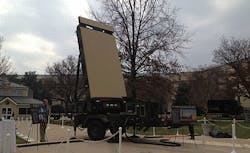Marines ask Northrop Grumman to switch G/ATOR radar computers from Windows to Linux software
Officials of the Marine Corps Systems Command at Quantico Marine Base, Va., announced a $10.2 million contract modification Wednesday to the Northrop Grumman Corp. Electronic Systems segment in Linthicum Heights, Md., to convert the Ground/Air Task-Oriented Radar (G/ATOR) operator command and control computer from Windows XP to Linux.
The contract modification will incorporate a change order to switch the G/ATOR control computer from the Microsoft Windows XP operating system to a Defense Information Systems Agency (DISA)-compliant Linux operating system.
Related: After nine years, Marine Corp finally may have full production of G/ATOR radar in sight
G/ATOR is an expeditionary, three-dimensional, short-to-medium-range multi-role radar system designed to detect low-observable targets with low radar cross sections such as rockets, artillery, mortars, cruise missiles, and UAVs.
The G/ATOR computer switch from Windows XP to Linux is one of many changes imposed on the long-delayed and expensive radar system that has been in development for the past nine years.
Linux is an open-source software operating system related to the Unix operating system and the Posix operating system interface that has become popular with the military because of its ease of use, reliability, and affordability.
In October the Marine Corps. awarded a $207.3 million contract modification to Northrop Grumman for four prototype Ground/Air Task-Oriented Radar (G/ATOR) systems as a step toward full system production.
Related: Marines ask Northrop Grumman to take next step in Ground Weapons Locating Radar (GWLR)
Marine Corps leaders are developing and fielding G/ATOR in three blocks for use by the Marine Air Ground Task Force across the range of military operations, officials say.
G/ATOR development began in 2005 with a $7.9 million contract to Northrop Grumman Electronic Systems. At the time the three-increment G/ATOR development involved short-range air surveillance, counter-battery fire and target acquisition, and sensor networking.
The program's first increment asked Northrop Grumman to build G/ATOR for short-range air defense (SHORAD) and tactical air operations Center (TAOC) air surveillance missions, including IFF. The increment I design was to provide for growth to all following increments without equipment re-design and provide an open architecture to enable computer upgrades with the functionality of all following increments.
Related: Marine Corps G/ATOR radar system is early design-in win for VPX embedded computers
The second increment was to develop and produce systems based on the increment I baseline for ground counter-battery and target acquisition. The third increment was to incorporate Mode 5/S IFF, electronic protection equipment and software, non-cooperative target recognition, sensor netting, an advanced radar environmental simulator, and a logistics integrated data environment (IDE).
The G/ATOR program was to showcase new component technologies, including the then-new VPX embedded computing fast switch-fabric interconnect. As part of the G/ATOR program's first increment, Northrop Grumman awarded a $4.3 million contract in 2008 to Curtiss-Wright Corp. for VPX-based embedded computers for radar signal processing, which were to be delivered by 2010.
(story continues below)
Curtiss-Wright supplied Northrop Grumman Electronic Systems with a rugged air-flow-through radar processing subsystem with VPX single-board computers and other open-architecture standards and software for the G/ATOR processor.
Curtiss-Wright provided what then were considered the company's latest digital signal processing (DSP), field programmable gate array (FPGA) and single board computer products.
A fourth increment to G/ATOR was to incorporate an air traffic control (ATC) capability. That first contract back in September 2005 was to conclude in September 2009, and that's when problems cropped up.
Related: Marine Corps, Northrop Grumman team completes G/ATOR design review
By October 2009 the Pentagon reported a $14 million cost overrun to G/ATOR, which was blamed on additional capability added during the previous four years, and to unexpected developments like the rising cost of gold, which made advanced electronic connectors for the military radar more expensive. The use of VPX technology was not blamed for any delays or cost overruns.
By mid-2012 -- nearly seven years after the program began -- the Marine Corps awarded a contract to Northrop Grumman to begin the second increment of developing the Ground Weapons Locating Radar (GWLR) portion of G/ATOR.
This 2012 GWLR work involved software installed on the first increment's hardware and operating system software, which Northrop Grumman engineers designed.
Related: LaBarge wins $1.1 million contract from Northrop Grumman for G/ATOR radar system
The GWLR portion of the G/ATOR program uses active electronically scanned array (AESA) radar technology to enable the system to provide several different radar missions and adapt automatically to changing battlefield conditions. The GWLR is intended to offer the Marines a increase in detection range, accuracy, and deployability over other counter-battery radar systems.
By this phase of the G/ATOR program, the GWLR included interfaces to the U.S. military Advanced Field Artillery Tactical Data System (AFATDS) located in deployed fire-direction centers. The GWLR was intended to provide 24-hour target-acquisition capability to detect mortars, artillery, and rockets as far away as 45 miles.
On the contract modification announced this week Northrop Grumman will do the work in Syracuse, N.Y. and Linthicum Heights, Md., and should be finished by September 2016.
For more information contact Northrop Grumman Electronic Systems online at www.northropgrumman.com.
